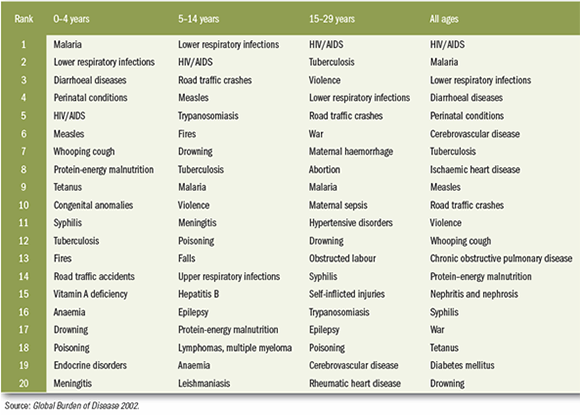- HEALTH TOPICS |
- INT'AL CLASS'N OF DISEASES |
- AIDS GLOSSARY |
- ANATOMY |
- DRUGS |
- USA STATS |
- CHINA STATS |
- GENOME DICTIONARY |


HEALTH TOPICS A TO Z
Facts about health in the African Region of WHO
INFECTIOUS DISEASES
HIV/AIDS
- The African Region has 11% of the world’s population, but an estimated 60% of people with HIV/AIDS.
- HIV/AIDS is the leading cause of death for adults in the Region.
- The number of HIV-positive people on antiretroviral treatment increased eight-fold between December 2003 and December 2005: from 100 000 to 810 000.
Malaria
- Malaria is endemic in 42 of the 46 countries of the African Region.
- More than 90% of the estimated 300–500 million clinical cases of malaria that occur across the world every year are in Africans, primarily children under the age of five years.
- There are nearly a million deaths due to malaria each year, the vast majority among children under five.
- Artemisinin-based combination therapies – the most effective antimalarial treatments available today–have been adopted by 33 countries as first-line treatment, but only 9 were implementing such treatment policies in 2006.
Tuberculosis
- An estimated 2.4 million new tuberculosis cases – 24% of all notified cases worldwide – and half a million tuberculosis deaths are reported in the Region each year.
- Tuberculosis has been on the rise in tandem with HIV/AIDS, because people with HIV, whose immune systems are weakened, easily contract tuberculosis and go on to develop active tuberculosis.
- Tuberculosis was declared a public health emergency in the African Region in 2005.
TROPICAL DISEASES
River blindness (onchocerciasis) has been eliminated as a public health problem.
Guinea worm (dracunculiasis) control efforts have resulted in a 97% reduction in cases since 1986.
Leprosy is close to elimination – meaning there is less than one case per 10 000 people in the Region.
PREVENTABLE CHILDHOOD ILLNESSES
Polio has nearly been eradicated.
Measles deaths have declined by more than 50% since 1999. In 2005, 75 million children received measles vaccines, and 37 countries were vaccinating 60% or more of their children against the disease.
URBANIZATION
- Currently about 37% of Africans live in cities, but the proportion is expected to reach 53% by 2030.
- An estimated 72% of city-dwellers in sub-Saharan Africa live in slums.
- Only 58% of the population in sub-Saharan Africa had access to safe water supplies and only 36% had access to sanitation in 2002.
MATERNAL AND CHILD HEALTH
- Of the 20 countries with the highest maternal mortality rates, 19 are in Africa. In 2002, in the African Region, an estimated 231 000 women died due to pregnancy and childbirth complications.
- The African Region’s neonatal death rate is the highest in the world. An estimated 43 out of every 1000 babies born in 2005 died during their first 28 days of life.
- Deaths among African children have been on the rise. In 1960, 14% of deaths among children under five years of age worldwide occurred in the Region. That proportion had risen to 23% in 1980 and 43% by 2003.
NONCOMMUNICABLE DISEASES AND INJURIES
- Noncommunicable diseases, such as hypertension, heart disease, diabetes and stroke and injuries represented 27% of the total burden of disease in the Region in 2001 and are on the rise. Surveys in Cameroon, Congo, Eritrea and Mozambique have found a very high prevalence levels of risk factors for these diseases.
- By adopting broad prevention plans African countries could achieve 10 more healthy life years for their people.
- Road traffic collisions are a major health problem in countries in the Region. For example, road traffic collisions costs the Ugandan economy US$ 101 million each year, which is 2.3% of gross national product.
Leading causes of death by age in the African Region, 2002

|
Burden of communicable diseases and complications of pregnancy and childbirth

|
In the African Region, 72% of all deaths are from communicable diseases, such as HIV/AIDS, tuberculosis, malaria, respiratory infections and the complications of pregnancy and childbirth; compared to 27% in all other WHO Regions combined.
Sources: US Department of Health; The World Health Organization
- Please bookmark this page (add it to your favorites)
- If you wish to link to this page, you can do so by referring to the URL address below.
https://allcountries.org/health/facts_about_health_in_the_african_region_of_who.html
Copyright © 1995-2020 Photius Coutsoukis (All Rights Reserved)







